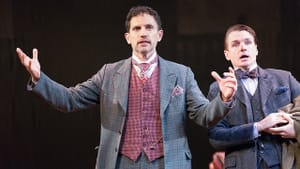Stay in the Loop
BSR publishes on a weekly schedule, with an email newsletter every Wednesday and Thursday morning. There’s no paywall, and subscribing is always free.
Sherlock in Wonderland
Philadelphia Theatre Company’s ‘Baskerville’

Sir Arthur Conan Doyle has been dead for 85 years, but his wildly popular fictitious detective character Sherlock Holmes survives to this day as the archetype of Victorian society’s faith in the triumph of reason. In 60 stories written after 1890, Holmes inevitably triumphed by seeing through fakery and artifice, no matter how convincing it seemed to the emotional dolts around him. As Holmes’s worshipful sidekick Dr. Watson insists (just before getting conked on the head) in Ken Ludwig’s hilariously inventive Baskerville, “The world is rational — it has to be.”
Yet astute readers of the above paragraph will surely point out that the very notion of “faith in reason” is an oxymoron. The great detective Holmes was not above ingesting artificial stimulants or grand opera to sharpen his wits; “There’s nothing like a little musical mayhem to clear the mind,” he explains to Watson in Baskerville. And Conan Doyle himself, after losing his son to influenza in 1918, became a convinced spiritualist and author of a dozen books that vigorously championed attempts by the living to contact the dead.
Like Monty Python
Holmes’s appeal to readers lay in his uncanny ability to, as another eminent Victorian, Rudyard Kipling, put it, use his head while others about him were losing theirs. In The Hound of the Baskervilles (1901-02), for example, Holmes was enlisted to solve a series of murders on a forlorn country estate that seemed to all the neighbors to have been committed by some monstrous and perhaps supernatural hound. Holmes, of course, knew better: In a rational world, there’s a good explanation for everything and no place for monsters.
Ken Ludwig’s Baskerville is less interested in the fun of detection than in the fun of spoofing the great detective’s presumptions. Here Holmes (Ron Menzel) and Watson (Henry Clarke) are less rational observers than bewildered Alices struggling through a madcap theatrical wonderland where nothing really does make sense: Furniture, flowers, butterflies, and of course hounds appear and disappear in a flash. Characters speak in unintelligible accents like actors in a Monty Python skit. (Describing her demented criminal brother to Holmes, the caretaker of Baskerville Hall explains, “His name is Wiktor. He is a conwict.”)
Costume change
But the greatest source of confusion, and of audience delight, lies in the menagerie of characters Holmes and Watson encounter in their quest — all played in high-caricature mode by just three actors (Adam Green, Matt Zambrano, and Crystal Finn), who constantly rush offstage to change their costumes (and sometimes their genders). By the end of the second act, these characters/actors have abandoned all effort to deceive Holmes (or us) and simply switch their clothing or hats onstage. Ultimately Baskerville becomes a triumph not of Victorian reason but of modern theatrical timing and stagecraft, all brilliantly choreographed by Amanda Dehnert.
Holmes solves the case in the end, of course, but that’s beside the point. In Baskerville, the hilarious process matters more than the product. The Holmes novels provided a treat for the mind; Baskerville is a treat for the mind and the eye as well. The funny bone, too.
For Gary L. Day’s review of this production, click here.
For Mark Cofta's review of the March 2015 production at the McCarter Theatre, click here.
What, When, Where
Baskerville. By Ken Ludwig; Amanda Dehnert directed. Philadelphia Theatre Company production through December 27, 2015 at Suzanne Roberts Theatre, 480 S. Broad St. (at Lombard), Philadelphia. 215-985-0420 or PhiladelphiaTheatreCompany.org.
Sign up for our newsletter
All of the week's new articles, all in one place. Sign up for the free weekly BSR newsletters, and don't miss a conversation.

 Dan Rottenberg
Dan Rottenberg